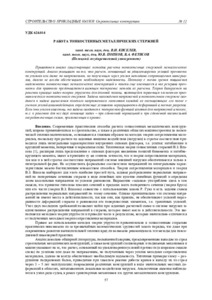Please use this identifier to cite or link to this item:
https://elib.psu.by/handle/123456789/1332Full metadata record
| DC Field | Value | Language |
|---|---|---|
| dc.contributor.author | Киселев, В. Н. | - |
| dc.contributor.author | Попков, Ю. В. | - |
| dc.contributor.author | Фетисов, В. А. | - |
| dc.date.accessioned | 2014-02-18T14:22:57Z | - |
| dc.date.available | 2014-02-18T14:22:57Z | - |
| dc.date.issued | 2010 | - |
| dc.identifier.citation | Вестник Полоцкого государственного университета. Сер. F, Прикладные науки. Строительство. - 2010. - № 12. - С. 57-63. | ru_RU |
| dc.identifier.uri | https://elib.psu.by/handle/123456789/1332 | - |
| dc.description | WORK OF THIN-WALLED METAL RODS V. KISELEV, Y. POPKOV, V. FETISOV The analysis of existing methods of calculation of thin-walled rods of metal structures is made. Analysis indicates that the calculation is based on meeting the conditions of the strength of the efforts, or even the strain, but obtained through efforts of the methods of strength of materials do not always provide the necessary reliability. Therefore, in terms of improving the reliability of thin-walled metal structures and search that are still in their reserves of strength to practice it is important to construct a method for calculating them. The theory is based on solving the boundary problems of elasticity theory for a long strip, which is a primary element of a prismatic thin-walled bar. The problem of finding the stresses in thin-walled rods is reduced to the problem of computing the plane stress state of each of its constituent bands, taking into account the efforts of the interaction determined by the conditions of continuity of deformations in the ground sections. If these efforts are known, the problem reduces to the construction of the influence functions for stresses in the strip, i.e. to the decision for it two main objectives – when the unit normal to the edge and the unit tangent to the edge of the concentrated forces. | ru_RU |
| dc.description.abstract | Приводится анализ существующих методов расчета тонкостенных стержней металлических конструкций. Анализ указывает на то, что расчет, основанный на удовлетворении условий прочности по усилиям или даже по напряжениям, но полученным через усилия методами сопротивления материалов, далеко не всегда обеспечивает необходимую надежность. Поэтому с точки зрения повышения надежности тонкостенных металлических конструкций и поиска еще имеющихся в них резервов прочности для практики представляется важным построение метода их расчета. Теория базируется на решении краевых задач теории упругости для длинной полосы, являющейся первичным элементом призматического тонкостенного стержня. Задача нахождения напряжений в тонкостенном стержне сводится к задаче вычисления плоского напряженного состояния каждой из составляющих его полос с учетом усилий взаимодействия, определяемых условиями неразрывности деформаций в местах разрезов. Если эти усилия известны, то задача сводится к построению функций влияния для напряжений в полосе, т.е. к решению для нее двух основных задач – при единичной нормальной и при единичной касательной сосредоточенным силам, приложенным к кромке. | ru_RU |
| dc.language.iso | ru | ru_RU |
| dc.publisher | Полоцкий государственный университет | ru_RU |
| dc.relation.ispartof | Веснік Полацкага дзяржаўнага ўніверсітэта. Серыя F, Будаўніцтва. Прыкладныя навукі | be_BE |
| dc.relation.ispartof | Herald of Polotsk State University. Series F, Civil engineering. Applied sciences | en_EN |
| dc.relation.ispartof | Вестник Полоцкого государственного университета. Серия F. Строительство. Прикладные науки | ru_RU |
| dc.relation.ispartofseries | Сер. F, Прикладные науки. Строительство;2010. - № 12 | - |
| dc.rights | open access | ru_RU |
| dc.subject | Строительные конструкции | ru_RU |
| dc.subject | расчет конструкций | ru_RU |
| dc.title | Работа тонкостенных металлических стержней | ru_RU |
| dc.type | Article | ru_RU |
| Appears in Collections: | 2010, № 12 | |
Items in DSpace are protected by copyright, with all rights reserved, unless otherwise indicated.
